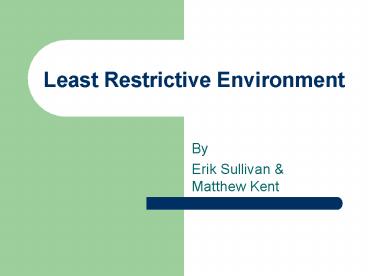Least Restrictive Environment - PowerPoint PPT Presentation
1 / 20
Title:
Least Restrictive Environment
Description:
The Individual with Disabilities Education Act. The Rehabilitation Act of 1973, Section 504 ... The Rehabilitation Act (Section 504) Services and Accommodations ... – PowerPoint PPT presentation
Number of Views:24
Avg rating:3.0/5.0
Title: Least Restrictive Environment
1
Least Restrictive Environment
- By
- Erik Sullivan Matthew Kent
2
HISTORY
- The Beginning
- The Changes of LRE
3
LAW
- Federal Law
- The Individual with Disabilities Education Act
- The Rehabilitation Act of 1973, Section 504
- Americans with Disabilities Act of 1990 (ADA)
- New York State Law and Regulations
- Article 89
- Part 200 of Regulations of the Commissioner of
Education
4
IDEA conditions
- Mental retardation
- Hearing impairment (including deafness)
- Speech or language impairment
- Visual impairment (including blindness)
- Serious emotional disturbance
- Orthopedic impairment
- Autism
- Traumatic brain injury
- Other health impairment
- Specific learning disability
- Deaf-blindness
- Multiple disabilities
5
IDEA Supports and services
- Assigning various teachers personal and other
service providers - Use of assertive technology devices
- Development of behavior intervention and support
plans - Modification of the general education
- Counseling
- Occupational therapy
- Physical therapy
- Orientation and mobility instruction
- School health services
- Speech and language therapy
- Vision education services
6
The Rehabilitation Act (Section 504) Services and
Accommodations
- Repeating and simplifying instructions about
in-class and homework assignments - Supplementing verbal instructions an viual
instructiion - Using behavioral mangament techniques
- Modifying test delivery
- Computer-aided instruction
- Arranging for reduced class sizes
- Classrooom aides and consultant teachers
- Scheduling accommodations
- Providing accessible facilities
7
Americans with Disabilities Act
- Prohibits discrimination against people with
physical or mental disabilities in all programs
of state and local governments, including public
and private, non-parochial schools. - Removal from school buildings of physical barriers
8
New York State Laws
- Article 89
- Children with disabilities be provided with
special education
- Regulations of the
- Commissioner of Education
- Service close as possible to the students house
- Not removed from an age-appropriate regular
classroom because of the need of modification in
the general curriculum
9
ATTITUDES
- Parents
- Peers
- Administrators
- Teachers
10
Classroom Activity
- How to support new friendships
- What can parents do?
- What can teachers do?
11
What can parents do?
- Create an environment in your home that attracts
kids. - Play detective.
- Sign your child up for community groups and
activities. - Help your child reach out to children she/he
likes. - Be sure your child has a typical routine.
- Use adult support only when necessary.
12
What can teachers do?
- Use cooperative learning approaches in classroom
activities. - Assist each student to engage in classroom
learning activities in a meaningful, valued way. - Promote the concept that all children have
strengths and gifts as well as areas which
require support. - Promote an open atmosphere of democracy in the
classroom. - Use the curriculum to talk about relationships.
13
Accommodation for Inclusion/LRE Classroom
- Physical Arrangement of Room
- Lesson Presentation
- Assignments/Worksheets
- Behaviors
14
Physical Arrangement of Room
- Seating student near the teacher
- Seating student near a positive role model
- Avoiding distracting stimuli
- Increasing distance between desks
15
Lesson Presentation
- Paring students to check work.
- Writing key points on the board.
- Providing peer tutoring.
- Including a variety of activities during each
lesson. - Having child review key points orally.
- Teaching through multiple intelligences.
16
Assignments/Worksheets
- Giving extra time to complete task.
- Simplifying complex directions.
- Reducing the reading level of the assignments.
- Giving frequent short quizzes and avoiding long
tests. - Recognize and give credit for students oral
participation in class. - Handing worksheets out one at a time.
17
Behaviors
- Use of timer to facilitate task completion.
- Praising specific behavior.
- Giving extra privileges and rewards.
- Allowing for short breaks between assignments.
- Marking students correct answers, not his
mistakes. - Implementing a classroom behavior management
system.
18
Classroom Activity
- You be the Judge!
19
Something to take away
- Equal education Is the foundation of the right
to be a human being This doesn't not mean that
any child or any other gifted child having a
greater capacity to learn may or shall be
deprived of his or her opportunity to learn more.
It does mean that every child shall have the
equal opportunity to learn to the best of his or
her ability. That opportunity must be made
available to all on equal terms. -Alfred
Gitelson
20
References
- Kavale, K. History, Rhetoric, and Reality.
Retrieved 3/29/03 www.web20.epnet.com - Least Restrictive Environment Coalition.
Retrieved 3/29/03 www.1recoalition.org - Moll, L. (1999) Least Restrictive Environment A
Place or a Context? Retrieved 3/29/03
www.web20.epnet.com - Siegel, L. (1994). Least Restrictive Environment
The Paradox of Inclusion. Pennsylvania LRP
Publications. - Stainback, W. Stainback, S. (1992).
Controversial Issues Confronting Special
Education. Massachusetts Allyn and Bacon.































